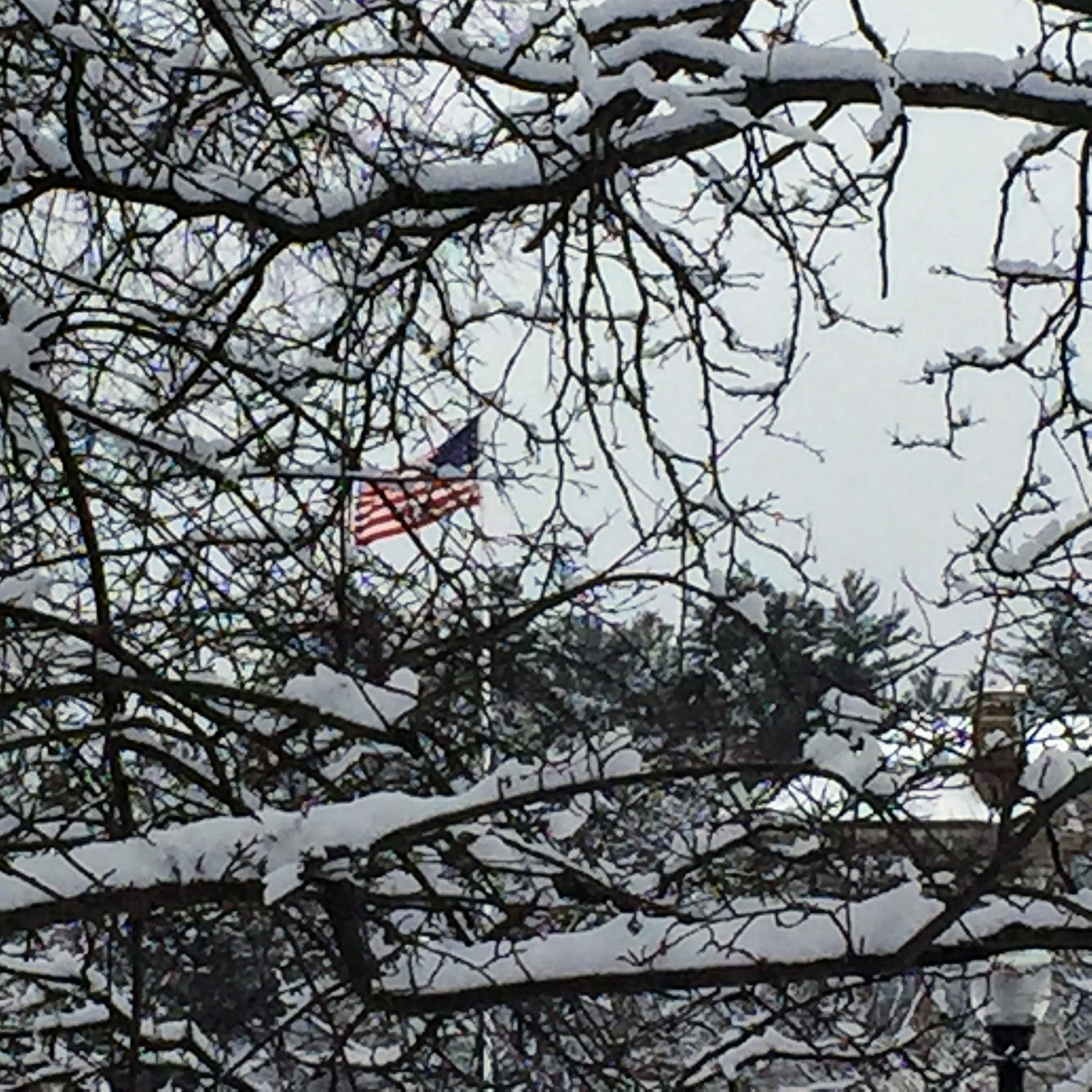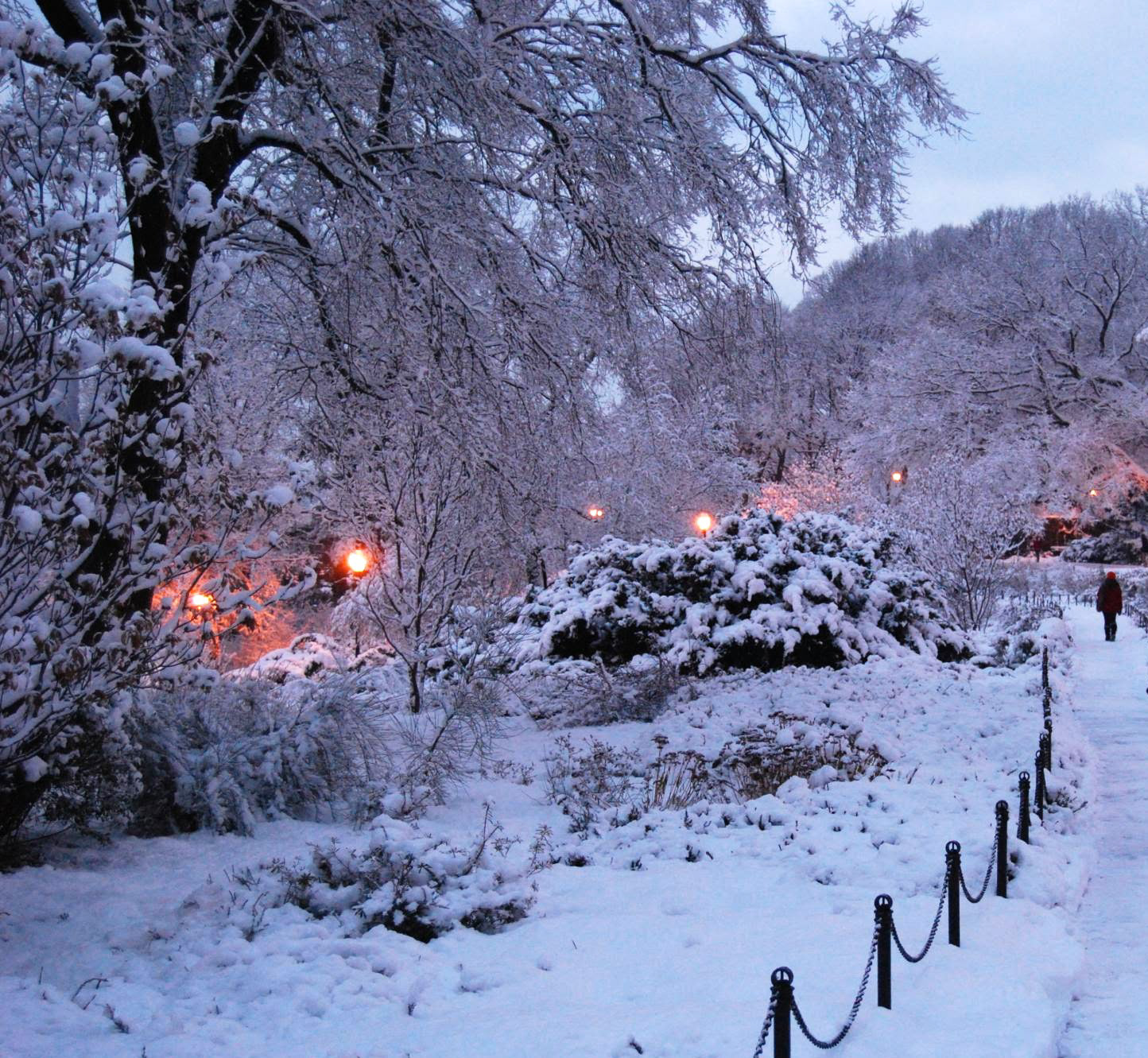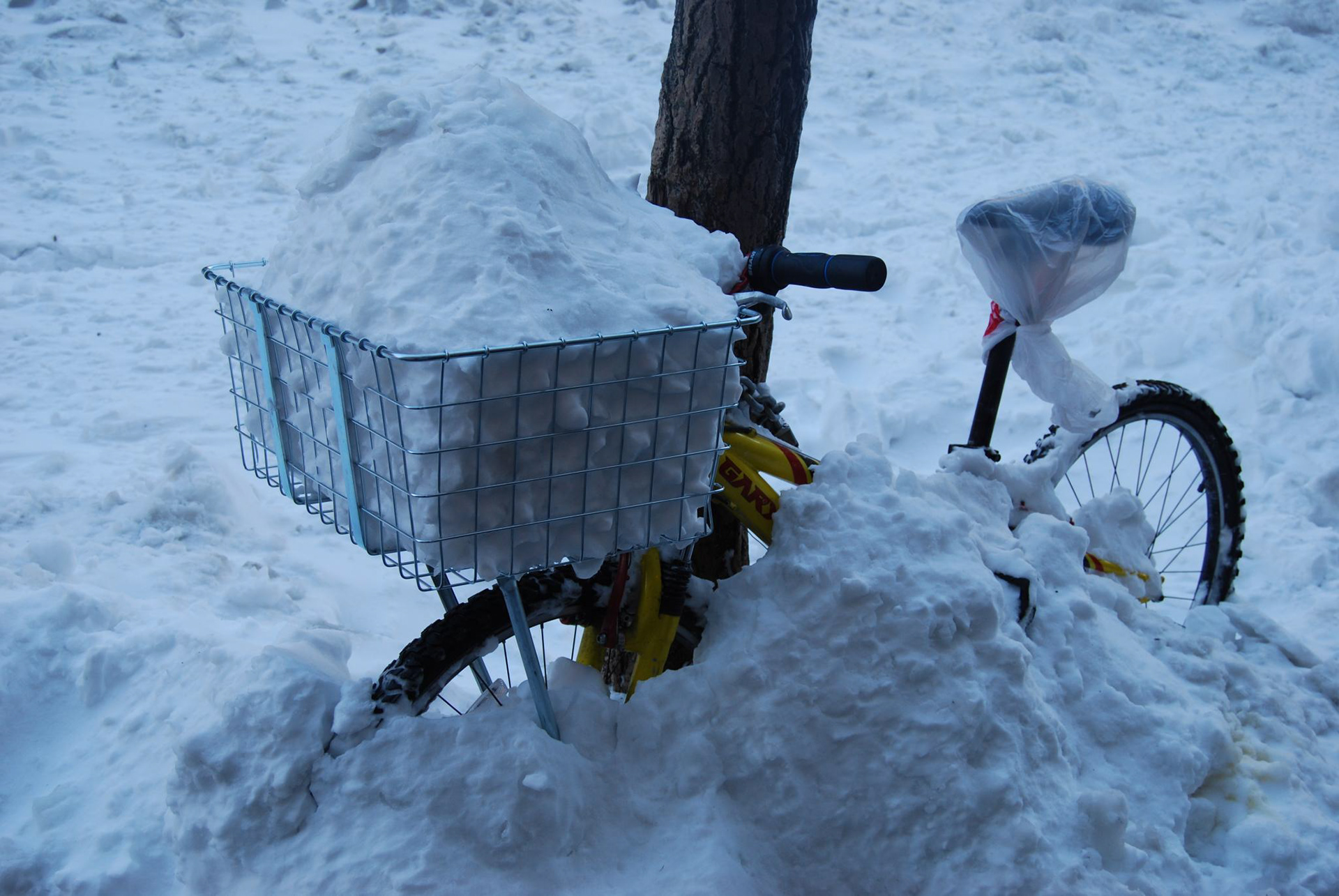On the life-affirming, death-defying nature of the white stuff
By Courtney Cook
(A version of this essay appeared in the weekly newsletter, Survival by Book)
Every time it starts to snow, I would like to have
sex. No matter if it is snowing lightly and unseri-
ously, or snowing very seriously, well on into the
night, I would like to stop whatever manifestation
of life I am engaged in and have sex, with the same
person, who also sees the snow and heeds it, who
might have to leave an office or meeting, or some ar-
duous physical task, or, conceivably, leave off having
sex with another person, and go in the snow to me,
who is already, in the snow, beginning to have sex in
my snow-mind.
sex. No matter if it is snowing lightly and unseri-
ously, or snowing very seriously, well on into the
night, I would like to stop whatever manifestation
of life I am engaged in and have sex, with the same
person, who also sees the snow and heeds it, who
might have to leave an office or meeting, or some ar-
duous physical task, or, conceivably, leave off having
sex with another person, and go in the snow to me,
who is already, in the snow, beginning to have sex in
my snow-mind.
—from “Snow,” by Mary Ruefle
I already know the story I will tell when I am old and cannot remember my name, nor where I am. It is a story of a snowy day on a hillside in Montana, and I will tell it so often that it will cause the robots that my children have purchased to care for me to roll their bionic eyes and my great grandchildren to tap the “blur sound” function on their cranial microchips.
I was sixteen or so, and still in high school, but I had a friend who’d graduated and gone on to Montana State University in Bozeman. One weekend I made the short five-hour drive from my hometown in Wyoming via the no speed limit “Montana Autobahn” to see him. A thick snow had started falling just as I’d arrived and was still snowing the next morning when my friend and I set out for Bridger Bowl–a blessed event, since there is possibly no other anticipation so sweet as the one that you feel when you drive toward a ski destination through thickly falling snow. It’s an unqualified harbinger of good things: if it’s snowing, it won’t be too cold; if it’s snowing pretty hard, a percentage of people will stay home which means no lift lines; and, above all other good things, if it’s snowing thickly enough, there will be the skier’s holy grail: ungroomed, unsullied, unbroken powder.
That day, the snow just kept coming down, and by afternoon, the powder was too light to float over but too thick to carve easily. Still, I persisted, making turn after turn, until I caught an edge and leaned too hard on my pole, but instead of catching me, it kept going down, down, down, so forcefully that I let go of it lest I be sucked down into the great snow void along with it. I skidded to a stop and sat down on the hill and looked at my empty right hand. The pole was gone, lost to a base of fresh snow that was now forty or fifty inches deep.
We kept going of course, because who really needs a pole anyway.
It was the best day of skiing I’ve ever had, which is why I will be telling the story of it even when the rest of my mind has left me. I will never replicate this day, not only because I will never be that young and strong again, but because the lift ticket probably cost $20 and in those days all I needed for gear was a powder jacket over my dad’s wool sweater and a pair of wool army pants that I got at a thrift store, and partly because I was heady in love, as only a sixteen-year-old can be, with the college boy with whom I’d perfected that maximalist skiing routine. There is nothing else better in the world than to be alone with someone when it’s snowing except maybe skiing with someone you are in love with while it’s snowing.

photo by Courtney Cook

photo by Courtney Cook

photo by Courtney Cook
Snowscapes, because they are among the best of all the things, are everywhere in literature. If there is a Russian novel that doesn’t have between one and several dozen plot points set in a snowy scene, I don’t know of it. If there is a children’s story that is better than The Snowy Day by Ezra Jack Keats, I don’t want to hear of it, unless you want to talk about Katy and the Big Snow by Virginia Lee Burton. (And ok, maybe also The Polar Express.) If there is a song for snow that is better than “The Outdoor Song which Has To Be Sung In The Snow” sung by Winnie the Pooh and Piglet in The House at Pooh Corner, then you will have to argue with not only me, but also the inimitable Dorothy Parker, who paid homage to “our recurrent hero” in this delightful piece written for the New Yorker in 1928.
Snow is often used to symbolize the end of a crisis or resolution. At the end of The Hobbit, Bilbo Baggins looks back on snow capped mountains and effectively sighs with relief: "'So comes snow after fire, and even dragons have their ending!' said Bilbo, and he turned his back on his adventure. The Tookish part was getting very tired, and the Baggins was daily getting stronger. 'I wish now only to be in my own arm-chair!' he said. "
When Charles Wallace and the unicorn Gaudior are trapped and choking to death on a hot, acrid, and lifeless “Projection” in A Swiftly Tilting Planet by Madeline L’Engle, Charles Wallace gasps the words of an ancient rune as a last resort: “I call on all Heaven with its power/And the sun with its brightness, and the snow with its whiteness,” and brings “pure white snow drifting down from the tortured sky, covering the ruined earth” to save him and their mission.
Likewise, some of the best, most suspense-filled writing in Phillip Pullman’s books happens in the snow-covered Arctic scenes in The Golden Compass. There is the scene in which Lyra first rides on the back of the polar bear king, Iorek Byrnison, underneath the Aurora Borealis through the “immense silence of the North;” the comic-tragic moment in which the children revolt against the menace of the “silver guillotine” by throwing snowballs at their captors; and the dramatic rescue when Lyra and Roger are pulled “upward into the snow-thick air” by the good-hearted wanderer Lee Scoresby’s somehow not anachronistic hot air balloon.
There is snow-writing for older kids, too. The mid-century British author Elizabeth Goudge called her autobiography The Joy of the Snow, and offered us this lovely evocation.
The snow-light filling the house with magic as the white flakes drifted down in windless silence, the splendour when the sun came out and hills and fields and trees sparkled under the arc of blue sky, the thought of the things one did in the snow, tobogganing and snow balling and building a snowman; it was all ecstasy. And somewhere tucked away at the back of one’s mind was the knowledge that every crystal in the vast whiteness, though too small for the human eye to see, was fashioned like a flower or a star. How could snow not be the wonder of the world?
There is also the best of the best: James Joyce’s short story, “The Dead,” in which the steadily falling snow is a running motif. Here are the famous last lines:
It had begun to snow again. He watched sleepily the flakes, silver and dark, falling obliquely against the lamplight . . . It was falling on every part of the dark central plain, on the treeless hills, falling softly upon the Bog of Allen and, farther westward, softly falling into the dark mutinous Shannon waves . . . It lay thickly drifted on the crooked crosses and headstones, on the spears of the little gate, on the barren thorns. His soul swooned slowly as he heard the snow falling faintly through the universe and faintly falling, like the descent of their last end, upon all the living and the dead.
In “The Dead” the snow is a multilayered metaphor, conveying the vicissitudes of memory and history, and serving as part of the veneer of gentility that cracks over the course of the story as the protagonist, Gabriel Conroy, comes up against his assumptions about class, politics, and even his wife.
The truth is that snow, for all of its delightful qualities, is also a killer, and as such a fitting device for hearkening the reader to “crooked crosses and headstones.” In Jack London’s terrifying short story, “To Build a Fire,” it is the protagonist’s hubris about what it means to be out in -50 degrees that puts him at risk, but it is a snow-cloaked bough of a tree that sends him to his death.
He should not have built the fire under the pine tree. He should have built it in an open space. But it had been easier to pull the sticks from the bushes and drop them directly on the fire. Now the tree under which he had done this carried a weight of snow on its branches. No wind had been blowing for weeks and each branch was heavy with snow. Each time he pulled a stick he shook the tree slightly. There had been just enough movement to cause the awful thing to happen. High up in the tree one branch dropped its load of snow. This fell on the branches beneath. This process continued, spreading through the whole tree. The snow fell without warning upon the man and the fire, and the fire was dead.
I read this short story when I was maybe ten years old, and since I lived in Wyoming, in a climate where the temperatures regularly dipped to negative five or ten degrees in the winter, I had reason to take notice. London slowly, almost lovingly, unfolds each of the man’s hubristic missteps: the choice to go out at all, the choice to go out without a face guard, the dog’s growing unease, the climactic fall through the ice. It is a handbook of the deathly risks of snow and cold.
A book with a happier ending, but with a similar take on the deadly nature of snow, is Laura Ingalls Wilder’s The Long Winter. When I was a kid, this book seemed like all of the Little House books—full of adventure and interesting detail about pioneer life crossed with scenes of Pa’s fiddle and visitors who brought peppermint sticks to Laura and her sister. Later, when I read The Long Winter to my own kids, I had a different experience of it. As a grown-up, I found it astonishing that the supply system to the midwestern prairie towns was simply cut off for the winter because of the excessive snowfall. No trains ran for months. The Ingalls family had to twist hay for hours every day just to stay warm and ate bread made out of hand-ground wheat and not much else. It is a story of near starvation and deprivation. The penultimate scene, in which Laura Ingalls’s future husband, Almanzo Wilder, and his friend travel the across the slough to buy wheat for the starving town, is an excruciating odyssey of risk as their horses break through the crust of the snow drifts over and over, each time requiring the men to unhitch their sleds, dig out, settle the horses, and begin again.
And, just to circle back to the Russians for a moment. It’s not always snow as a backdrop to fur coats and ice skating in Moscow. One of the salient questions in Alexander Solzhenitsyn’s grueling yet triumphant One Day in the Life of Ivan Denisovitch is: “How can you expect a man who's warm to understand a man who's cold?” The only thing I’ve read that made me feel as emphatically and empathetically cold as Ivan Denisovitch’s better than average day in a gulag, is “To Build a Fire.”
Even Robert Frost’s beloved poem “Stopping by Woods on a Snowy Evening” is shot through with a suicidal longing, as if the threat of the cold is also a beckoning. The poet notes that his neighbor will not notice him, as he stops to “watch the woods fill up with snow.” There is clear temptation in this observation, and it is only the gentle insistence of the horse that calls the protagonist back to reason. There is a regret in these most famous lines that is not only about looking at a pretty snowscape.
The woods are lovely, dark and deep,
But I have promises to keep,
And miles to go before I sleep,
And miles to go before I sleep.
But I have promises to keep,
And miles to go before I sleep,
And miles to go before I sleep.
The recollection of what is owed to the living and the repetition of the last two lines, conveying a sense of resolve if not resignation, are the giveaways here.
It strikes me that one of the things that makes snow so wonderful is, in fact, the risk. Boston-based memoirist Nina MacLaughlin’s multi-part column “Winter Solstice” in the Paris Review gets at the core of this, especially in her December installment, “In Winter We Get Inside Each Other.” She writes about the fierce, primal, almost animalistic response that we have to cold and snow—how it brings life instinct roaring into opposition with the opposing forces of cold and dark.
The erotics of the dark, cold season differ from that of summer—not the flirty, sundressed frolic; not sultry August sweat above the lip; not tan lines or sand in shoes or voluptuous tulips. It’s a different sort of smolder now. Quilted, clutching, we wolve for one another, ice on the puddles and orange glow from windows against deepest evening blue. In summer: lust and laze, days are loose and lasting. In winter: time tightens, night’s wide open, the hunger says right now.

photo by Courtney Cook

photo by Courtney Cook

photo by Courtney Cook
“Such is winter love,” MacLaughlin writes, and I think she’s on to something in how the instinct to hibernate—whether metaphorically, in death, or, more literally, in a permanent state of flannel-clad, blanket covered sleepiness—is thankfully offset by a fierce energy for connection and closeness, a generative lurch toward finding another warm body. Maybe the allure of the snow is that it calls this instinct out of us, insists that we give in to our need for connection, companionship, and touch—overrides the hubris that says we can go it alone.
By the same token, what I love about Mary Ruefle’s poem, “Snow,” part of which is quoted at the top of this essay, is the unassailable assumption that snow calls forth our most primal, even comical, instincts. The poem runs the gamut between comedy—propositioning even someone who might “leave off having/sex with another person, and go in the snow to me—” to a clear-eyed contemplation of death as something that is happening concurrently, just outside the circle of her lovemaking. In a further section of the poem, the poet, now with her lover under blankets, lets her mind wander to a cemetery.
I love watching it snow on graves, how cold the
snow is, even colder the stones, and the ground is
the coldest of all, and the bones of the dead are in
the ground, but the dead are not cold, snow or no
snow, it means very little to them.
snow is, even colder the stones, and the ground is
the coldest of all, and the bones of the dead are in
the ground, but the dead are not cold, snow or no
snow, it means very little to them.
It’s a poem that mixes the erotic thrill of snow right in with the death, cold, and mortality.
I think this is what is so exhilarating about snow—the way it offers both risk and exhilaration. Snow makes us feel alive, precisely because it inspires us and can kill us. Aren’t all of the best things both/and?
February 2021
Courtney Cook is a writer based in Wilder, VT. She has degrees from Dartmouth College and the University of Wollongong, Australia, taught English literature for ten years, and now works as a technical writer and marketing manager. You can read her writing at the Los Angeles Review of Books and in her weekly newsletter, Survival by Book.
